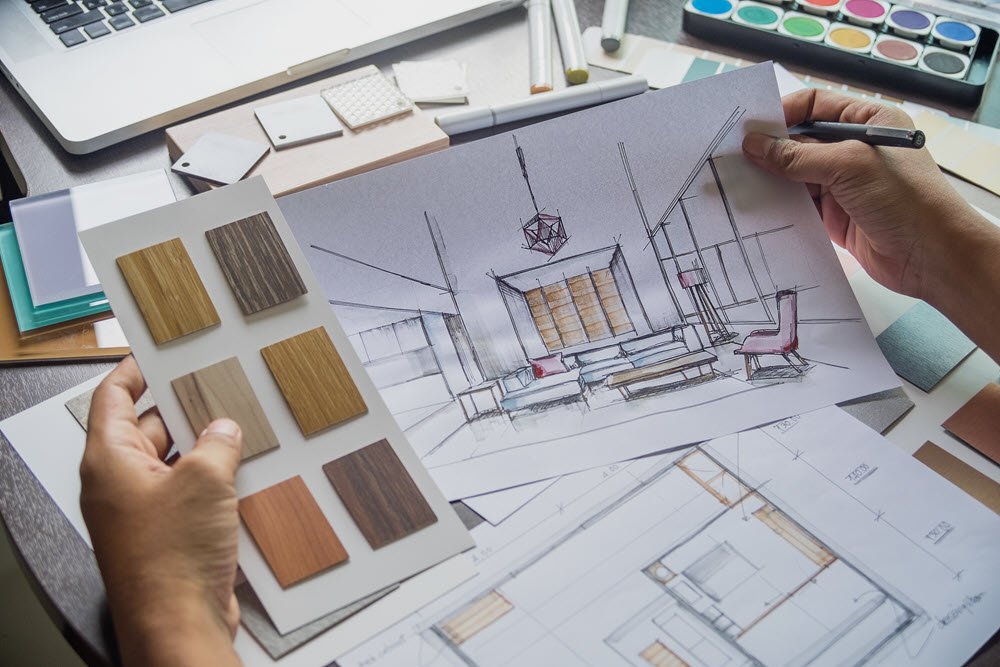Taking Full Advantage Of Visual Appeal: The Synergy Between Interior Design and Home Architect Strategies
Comprehending the refined interplay between indoor style and home architecture can substantially raise the aesthetic allure of a living area. This marriage of design disciplines includes a thoughtful assimilation of building elements with indoor formats, and a skillful application of concepts such as rhythm, equilibrium, and contrast. As we discover this synergy, we will certainly reveal methods to develop visually striking and useful atmospheres that not just show individual style, however also adjust to the dynamic requirements of modern-day living.
Understanding the Essentials: Defining Interior Design and Home Architecture
Interior decoration and home design, frequently linked, stand for the architectural and aesthetic elements of our home. Interior Design is a complex self-control that includes developing functional, risk-free, and cosmetically pleasing spaces inside a structure. It consists of elements such as furniture plan, color control, and accessory choice. On the other hand, home architecture largely concentrates on the solid framework of a building. It includes creating a useful and visually pleasing framework that stands the examination of time. It incorporates elements such as space construction, planning, and sustainability. Both areas call for a deep understanding of human actions, culture, and psychology. Each plays an essential role fit our living environments, contributing to our general comfort, efficiency, and wellness.
The Synergy Clarified: How Interior Layout and Home Design Intersect
Recognizing the synergy between interior decoration and home design can open a globe of creative thinking and capability. When discussing this crossway, the impact of architecture on interiors is an important facet to think about. This conversation will focus on the unifying layout concepts that blend these 2 areas right into a harmonious whole
Unifying Layout Principles
While it may seem that interior decoration and home architecture are 2 unique disciplines, they are really deeply interconnected, forming a harmony that is crucial for developing unified home. Unifying layout principles are the columns that facilitate this synergy. The principles consist of balance, rhythm, contrast, consistency, and emphasis. These aspects integrate to supply a cohesive visual allure. Balance develops a sense of security, rhythm offers a feeling of motion, consistency makes sure unity, contrast sparks passion, and emphasis accentuates essential aspects. The strategic application of these concepts allows a seamless blend of appearances and feature, enhancing the general experience of the area. Fundamentally, these principles offer as the bridge, unifying indoor layout and building practices.
Building Impact on Insides
The intertwining of indoor layout and architecture becomes even much more evident when one considers the building impact on insides. Architectural elements are inherent to a space's performance and aesthetics, shaping the layout from the start. Columns, arcs, light beams or stairs, for example, offer both ornamental and structural objectives. They can separate rooms, develop focal factors or imbue a space with a certain vibe. Consideration of proportion, texture, and light likewise stem from architectural influences. Ultimately, architecture mold and mildews the canvas upon which interior developers work. Their harmony is thus undeniable: style establishes the framework, which interior layout improves with texture, style, and shade. This symbiotic partnership guarantees a harmonious equilibrium between feature and appeal, optimizing the aesthetic allure of any area.
Trick Principles in Harmonizing Interior Design and Home Design
Striking an equilibrium in between capability and aesthetic appeal is a fundamental facet of integrating indoor design and home design. An equally crucial principle is the integration of sustainable design to produce green and energy-efficient homes. Understanding and checking out different architectural styles can likewise play a vital duty in accomplishing a harmonious design. Luxury home architect.

Balancing Capability and Aesthetic Appeal
Balancing functionality and visual appeals in indoor style and home design emerges as one of the vital principles to think about. Aesthetics boosts the state of mind and you can check here influences the understanding of area, whereas performance makes certain functionality and comfort. Just as crucial is the efficient arrangement of the room, with a tactical important site format adding significantly to the harmony in between performance and aesthetic appeals.
Sustainable Design Assimilation
In keeping the stability in between capability and visual appeals, one should also take into consideration the integration of sustainable design principles. This approach not just enhances the visual allure of a room yet likewise ensures its durability and decreased environmental impact. An unified combination of interior design and home architecture, guided by sustainability, can develop areas that are stunning, functional, and environmentally friendly.
Discovering Building Styles
While there are a wide variety of building designs to check out, it is vital to understand that every one brings its distinct principles that can substantially affect the harmonization of interior layout and home design. These designs, varying from the elaborate Baroque to the minimalist Modernist, lug unique philosophies and visual appeals that, when properly recognized and used, can create homes that are not just visually sensational yet likewise sympathetically integrated in terms of style and style. Picking an architectural style is not merely concerning personal visual choice; it is regarding picking a design language that you can find out more talks with the house owner's way of life, ideology, and goals, creating a home that is a true reflection of its citizens.
Situation Studies: Phenomenal Instances of Style and Architecture Synergy
Delving right into some remarkable case research studies supplies a profound understanding of exactly how design and architecture can sympathetically merge to create useful and engaging areas. Wright's style masterfully incorporates the home with its surrounding landscape, while the interior mirrors the outside's natural forms. These examples illustrate the importance of harmony in between interior layout and design in attaining aesthetic and functional success.
Practical Tips: Enhancing Your Home's Visual Charm
Attracting ideas from the instance research studies of building and design synergy, home owners also can carry out some practical methods to enhance their home's aesthetic charm. An unified mix of colors, appearances, and lighting can enhance an area, developing a cozy and inviting environment. Inevitably, the aesthetic appeal exists in balancing capability with design, producing a home that is both attractive and livable.

Future Trends: Just How Modern Techniques Are Transforming Interior Design and Architecture
As the globe advances, so do the trends in interior style and style. Modern techniques are increasingly concentrating on sustainability, including energy-efficient layouts and environmentally friendly materials. These patterns mirror a change in the direction of designs that are not just aesthetically pleasing, however likewise eco aware, technically progressed, and versatile to transforming lifestyles.
Final thought
In verdict, the combination of interior design and home design strategies is a dynamic method to enhancing visual allure. By leveraging crucial concepts like comparison, rhythm, and balance, and incorporating components of modern-day living, designers can develop versatile, aesthetically pleasing atmospheres. Through recognizing this synergy, homeowners can make enlightened decisions that not just elevate their living rooms however likewise add to their total health.
Understanding the refined interplay between indoor design and home design can considerably raise the aesthetic charm of a living room.Indoor style and home design, commonly intertwined, represent the aesthetic and structural aspects of our living areas.While it may appear that interior layout and home design are 2 distinct techniques, they are really deeply interconnected, creating a synergy that is crucial for producing unified living areas.The intertwining of indoor design and design comes to be also much more evident when one considers the architectural impact on interiors. A harmonious blend of indoor design and home design, led by sustainability, can create areas that are beautiful, practical, and eco friendly.